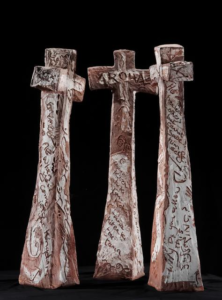Ceramics, one of New Zealand’s most enduring and significant crafts, is characterised today by a freedom of expression and technique. Non-functional forms predominate and are created through techniques including hand building, slip cast and wheel thrown. Materials range from earthenware to porcelain. From the single object to the installation format, subjects include re-interpretation of ceramic traditions, personal narratives, art movements, popular culture and environmental issues. A local perspective has, at times, emerged through such ideas.
Tertiary art and design education has supported ceramics practice, especially in Otago, Whanganui, and Auckland. Otago Polytechnic’s Diploma in Ceramic Arts remains the only specialised tertiary programme in ceramics studies. The annual Portage Ceramic Awards (established in 2001) have helped promote and support New Zealand practitioners through financial rewards and residencies. D ealer galleries also create visibility of ceramic practices.
ealer galleries also create visibility of ceramic practices.
Prominent mid-career practitioners include Wellington based Richard Stratton and New Plymouth based Paul Maseyk. Both artists draw on differing ceramic and art histories and combine them with narrative schemes. From Dunedin, Jim Cooper, with partners Madeleine Child and Philip Jarvis, create colourful, figurative work drawing on popular culture. Child and Jarvis focus too on environmental sustainability, at times working with commonly used household materials. Hutt Valley based “outsider artist” Robert Rapson, draws on local history with his handbuilt figurative forms. Auckland based artists Lauren Winstone and Isobel Thom critically engage with functionality highlighting the relationship between art and craft practices. Tony Bond, Erica van Zon and London-based artist Francis Upritchard are three artists currently contributing to this field.
Domestic pottery remains of interest although artists expand too into broader conceptual ideas. Wellington based Katherine Smyth creates domestic ware while also maintaining an interest in botanical and zoomorphic figurative ware. Raewyn Atkinson, from Wellington, explores human endeavour through porcelain. Chris Weaver from the West Coast, South Island, draws ideas from his rural environment. Martin Poppelwell’s domestic objects remain symbols of function while also referencing local commercial factory shapes and text based art practice.
 Anglo-Oriental traditions which dominated mid-twentieth century ceramics in New Zealand remain visible and include practitioners Duncan Shearer of Paeroa and senior potter Paul Melser of Carterton.
Anglo-Oriental traditions which dominated mid-twentieth century ceramics in New Zealand remain visible and include practitioners Duncan Shearer of Paeroa and senior potter Paul Melser of Carterton.
Contemporary ceramics were more recently explored through Nga Kaihanga Uku, a collective of Māori clay workers formed in 1986. Drawing from customary Māori culture, the collective included Colleen Urlich (d 2015), Baye Riddell, Manos Nathan (d 2015), Wi Taepa and Paerau Corneal.
Prominent senior practitioners explore alternative approaches to Anglo-Oriental traditions. They include Bronwynne Cornish (Auckland), John Parker (Auckland), Peter Lange, Richard Parker (Northland) and Ann Verdcourt from Dannevirke.
Further reading
Lopdell House Gallery, The Portage Ceramic Awards 2006 (Auckland: Lopdell House Gallery, 2006)





